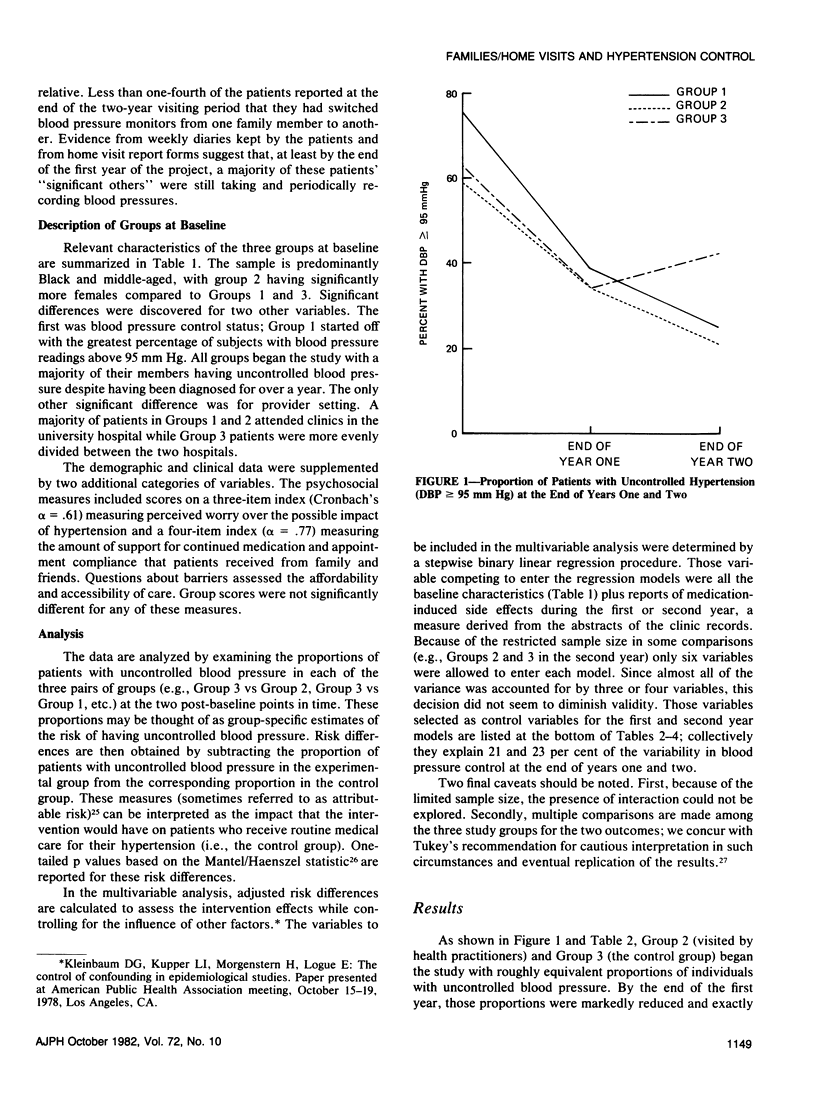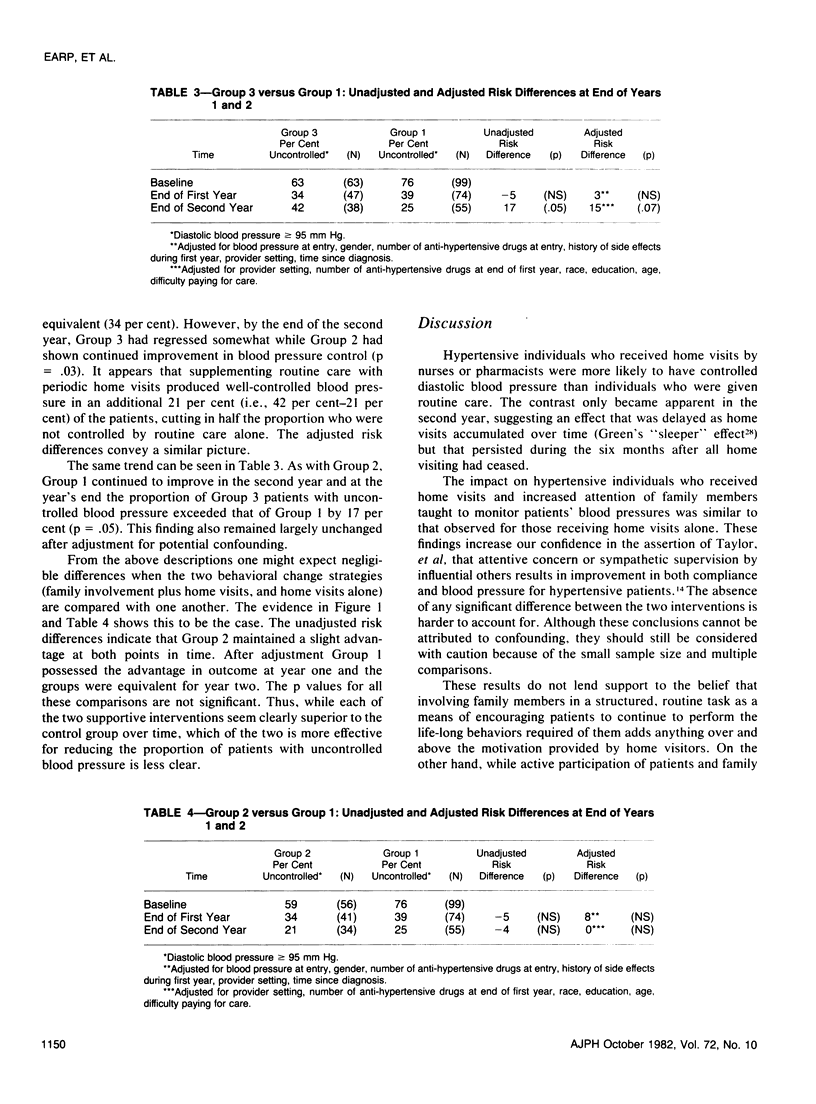Abstract
The effectiveness of two social support strategies designed to lower hypertensive patients' blood pressure were compared to each other and to a control group (N = 63) receiving routine care in a randomized clinical trial extending over a period of two years. Group 1 (N = 99) received visits and had family members actively participate in their care through home blood pressure monitoring; Group 2 (N = 56) received home visits from nurses and pharmacists. All groups were predominantly Black. After the first year of the trial, the proportion of patients with uncontrolled diastolic blood pressure (greater than or equal to 95mm Hg) had declined significantly for all three groups; no group showed a statistically significant advantage. However, during the last six months of the second year (after visiting had ended), both Groups 1 and 2 demonstrated clear superiority in DBP control over Group 3, achieving borderline statistical significance (p = .07) when multivariable analysis was performed to control for potential confounders. Supplementing routine care with periodic home visits produced an additional 21 per cent of patients with well-controlled DBP, while involving family members plus visits produced a 17 per cent improvement in the percentage of patients with DBP less than 95mm Hg. However, neither support strategy was clearly more effective than the other over time. The efficacy of the interventions is discussed with respect to cost and feasibility of implementation.
Full text
PDF








Selected References
These references are in PubMed. This may not be the complete list of references from this article.
- Glanz K., Kirscht J. P., Rosenstock I. M. Linking research and practice in patient education for hypertension: patient responses to four educational interventions. Med Care. 1981 Feb;19(2):141–152. doi: 10.1097/00005650-198102000-00002. [DOI] [PubMed] [Google Scholar]
- Green L. W. Evaluation and measurement: some dilemmas for health education. Am J Public Health. 1977 Feb;67(2):155–161. doi: 10.2105/ajph.67.2.155. [DOI] [PMC free article] [PubMed] [Google Scholar]
- Greenland S. Response and follow-up bias in cohort studies. Am J Epidemiol. 1977 Sep;106(3):184–187. doi: 10.1093/oxfordjournals.aje.a112451. [DOI] [PubMed] [Google Scholar]
- Hershey J. C., Morton B. G., Davis J. B., Reichgott M. J. Patient compliance with antihypertensive medication. Am J Public Health. 1980 Oct;70(10):1081–1089. doi: 10.2105/ajph.70.10.1081. [DOI] [PMC free article] [PubMed] [Google Scholar]
- Johnson A. L., Taylor D. W., Sackett D. L., Dunnett C. W., Shimizu A. G. Self-recording of blood pressure in the management of hypertension. Can Med Assoc J. 1978 Nov 4;119(9):1034–1039. [PMC free article] [PubMed] [Google Scholar]
- Kirscht J. P., Kirscht J. L., Rosenstock I. M. A test of interventions to increase adherence to hypertensive medical regimens. Health Educ Q. 1981 Fall;8(3):261–272. doi: 10.1177/109019818100800303. [DOI] [PubMed] [Google Scholar]
- Kirscht J. P., Rosenstock I. M. Patient adherence to antihypertensive medical regimens. J Community Health. 1977 Winter;3(2):115–124. doi: 10.1007/BF01674233. [DOI] [PubMed] [Google Scholar]
- Levine D. M., Green L. W., Deeds S. G., Chwalow J., Russell R. P., Finlay J. Health education for hypertensive patients. JAMA. 1979 Apr 20;241(16):1700–1703. [PubMed] [Google Scholar]
- MANTEL N., HAENSZEL W. Statistical aspects of the analysis of data from retrospective studies of disease. J Natl Cancer Inst. 1959 Apr;22(4):719–748. [PubMed] [Google Scholar]
- Maccoby N., Farquhar J. W., Wood P. D., Alexander J. Reducing the risk of cardiovascular disease: effects of a community-based campaign on knowledge and behavior. J Community Health. 1977 Winter;3(2):100–114. doi: 10.1007/BF01674232. [DOI] [PubMed] [Google Scholar]
- McKenney J. M., Slining J. M., Henderson H. R., Devins D., Barr M. The effect of clinical pharmacy services on patients with essential hypertension. Circulation. 1973 Nov;48(5):1104–1111. doi: 10.1161/01.cir.48.5.1104. [DOI] [PubMed] [Google Scholar]
- Nelson E. C., Stason W. B., Neutra R. R., Solomon H. S., McArdle P. J. Impact of patient perceptions on compliance with treatment for hypertension. Med Care. 1978 Nov;16(11):893–906. doi: 10.1097/00005650-197811000-00001. [DOI] [PubMed] [Google Scholar]
- Steckel S. B., Swain M. A. Contracting with patients to improve compliance. Hospitals. 1977 Dec 1;51(23):81-2, 4. [PubMed] [Google Scholar]
- Taylor D. W., Sackett D. L., Haynes R. B., Johnson A. L., Gibson E. S., Roberts R. S. Compliance with antihypertensive drug therapy. Ann N Y Acad Sci. 1978 Mar 30;304:390–403. doi: 10.1111/j.1749-6632.1978.tb25619.x. [DOI] [PubMed] [Google Scholar]
- Tukey J. W. Some thoughts on clinical trials, especially problems of multiplicity. Science. 1977 Nov 18;198(4318):679–684. doi: 10.1126/science.333584. [DOI] [PubMed] [Google Scholar]
- Walker W. J. Changing United States life-style and declining vascular mortality: cause or coincidence? N Engl J Med. 1977 Jul 21;297(3):163–165. doi: 10.1056/NEJM197707212970311. [DOI] [PubMed] [Google Scholar]
- Wilber J. A., Barrow J. G. Reducing elevated blood pressure. Experience found in a community. Minn Med. 1969 Aug;52(8):1303–1306. [PubMed] [Google Scholar]


